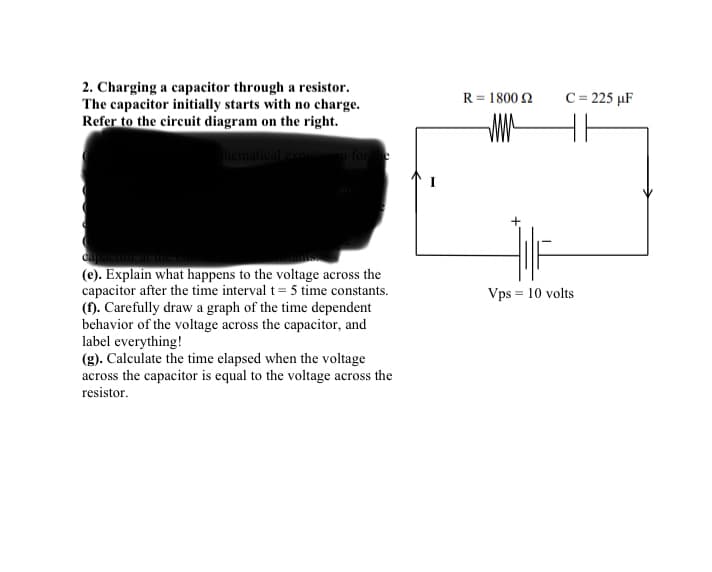2. Charging a capacitor through a resistor. The capacitor initially starts with no charge. Refer to the circuit diagram on the right. R = 1800 2 C = 225 µF hematical ex + (e). Explain what happens to the voltage across the capacitor after the time interval t= 5 time constants. (). Carefully draw a graph of the time dependent behavior of the voltage across the capacitor, and label everything! (g). Calculate the time elapsed when the voltage across the capacitor is equal to the voltage across the Vps = 10 volts resistor.
2. Charging a capacitor through a resistor. The capacitor initially starts with no charge. Refer to the circuit diagram on the right. R = 1800 2 C = 225 µF hematical ex + (e). Explain what happens to the voltage across the capacitor after the time interval t= 5 time constants. (). Carefully draw a graph of the time dependent behavior of the voltage across the capacitor, and label everything! (g). Calculate the time elapsed when the voltage across the capacitor is equal to the voltage across the Vps = 10 volts resistor.
College Physics
1st Edition
ISBN:9781938168000
Author:Paul Peter Urone, Roger Hinrichs
Publisher:Paul Peter Urone, Roger Hinrichs
Chapter19: Electric Potential And Electric Field
Section: Chapter Questions
Problem 6PE: Integrated Concepts (a) What is the average power output of a heart defibrillator that dissipates...
Related questions
Question
How to find g? Please explain so I can understand.

Transcribed Image Text:2. Charging a capacitor through a resistor.
The capacitor initially starts with no charge.
Refer to the circuit diagram on the right.
R = 1800 2
C = 225 µF
hematical ex
+
(e). Explain what happens to the voltage across the
capacitor after the time interval t= 5 time constants.
(). Carefully draw a graph of the time dependent
behavior of the voltage across the capacitor, and
label everything!
(g). Calculate the time elapsed when the voltage
across the capacitor is equal to the voltage across the
Vps = 10 volts
resistor.
Expert Solution
This question has been solved!
Explore an expertly crafted, step-by-step solution for a thorough understanding of key concepts.
Step by step
Solved in 2 steps with 2 images

Knowledge Booster
Learn more about
Need a deep-dive on the concept behind this application? Look no further. Learn more about this topic, physics and related others by exploring similar questions and additional content below.Recommended textbooks for you

College Physics
Physics
ISBN:
9781938168000
Author:
Paul Peter Urone, Roger Hinrichs
Publisher:
OpenStax College


College Physics
Physics
ISBN:
9781938168000
Author:
Paul Peter Urone, Roger Hinrichs
Publisher:
OpenStax College
